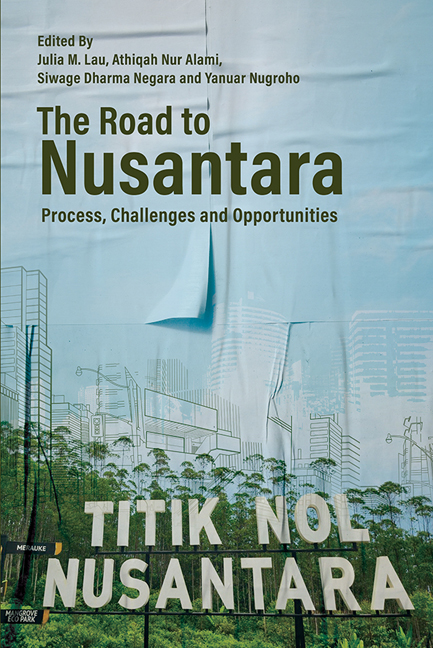Book contents
- Frontmatter
- Contents
- List of Figures
- List of Tables
- Foreword
- Foreword
- The Contributors
- Glossary
- Introduction: The Road to Nusantara—Process, Challenges and Opportunities
- PART I PROCESSES AND PATHWAYS TOWARDS NUSANTARA
- PART II CHALLENGES IN DEVELOPING NUSANTARA
- PART III OPPORTUNITIES FOR NUSANTARA
- Conclusion: Shaping Nusantara
- Index
9 - Nusantara the Green Capital: Leveraging Moment for Improved Forest Governance
Published online by Cambridge University Press: 01 March 2024
- Frontmatter
- Contents
- List of Figures
- List of Tables
- Foreword
- Foreword
- The Contributors
- Glossary
- Introduction: The Road to Nusantara—Process, Challenges and Opportunities
- PART I PROCESSES AND PATHWAYS TOWARDS NUSANTARA
- PART II CHALLENGES IN DEVELOPING NUSANTARA
- PART III OPPORTUNITIES FOR NUSANTARA
- Conclusion: Shaping Nusantara
- Index
Summary
INTRODUCTION
On 16 August 2019, President Joko Widodo officially announced the relocation of the capital city (or Ibu Kota Negara, IKN) in his state address. The new IKN, named Nusantara, is in East Kalimantan's regencies of Kutai Kartanegara and North Penajam Paser. It will have an area of 256,142.72 ha, including a core city of up to 56,180.87 ha and the main government zone of 5,644 ha. It is divided into three zones, the Central Government Core Area (Kawasan Inti Pusat Pemerintahan, KIPP), the State Capital Area (Kawasan IKN, KIKN), and the National Capital Development Area (Kawasan Pengembangan IKN, KPIKN). According to Bappenas, the goal of the IKN relocation is to realize the Golden Indonesian Vision 2045 (Visi Indonesia Emas 2045), one of whose aims is to create a new economic growth centre, apart from the previously Java-centric one.
East Kalimantan has a large forest, covering more than half of its total provincial area. However, the level of environmental damage, particularly in this forest area, is prominent. Its forest damage has reached 9.7 million ha (60 per cent). Thus, many parties, especially environmental civil society groups, at local and national levels, have been resistant to the development of the IKN, which is expected to further damage the forest. However, the Indonesian government, through Bappenas, has asserted that the IKN would be built by implementing a “forest city” concept, prioritizing environmental factors, to realize the vision of a “Smart, Green, Beautiful, and Sustainable City”. Based on the UU IKN (IKN Law), the new capital city is managed by Badan Otorita IKN Nusantara (Nusantara Capital City Authority, NCCA), including its environmental aspects.
This chapter discusses how the relocation of IKN, with its concepts of “Green City” and “Forest City”, can be an opportunity for improved forest governance. It uses a case-study approach with a qualitative method, using in-depth interviews and focus-group discussions as primary data collection techniques complementing secondary data from published sources. Based on the data related to forest management in Kalimantan, at least three forestry issues could become the cornerstone of the management model on a broader scale. They are: (1) deforestation and forest degradation, (2) overlapping land concession, and (3) human-wildlife conflict (HWC).
- Type
- Chapter
- Information
- The Road to NusantaraProcess, Challenges and Opportunities, pp. 197 - 224Publisher: ISEAS–Yusof Ishak InstitutePrint publication year: 2023

